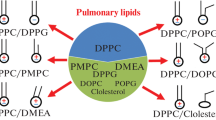Abstract
Purpose. The purpose of this study is to investigate the interaction of cationic polyamino acids, polylysine and polyarginine, with rat pulmonary surfactant at the air/water interface.
Methods. Surface pressure measurements of rat pulmonary surfactant in the presence and absence of polyamino acids were carried out in both dynamic and static modes.
Results. In dynamic cycle studies, compression and expansion of adsorbed surfactant films in the presence of the cationic polyamino acids resulted in a delayed attainment of the plateau surface pressure. In area studies of spread surfactant films at constant surface pressure, cationic polyamino acids in the subphase resulted in an increase in film area. Increased film area was also observed when a polyamino acid was injected beneath films of dipalmitoyl-phosphatidylcholine/phosphatidylglycerol. In the presence of the cationic polyamino acids, the equilibrium surface pressure (at constant film area) of pulmonary surfactant was elevated in a concentration- and molecular weight-dependent manner.
Conclusions. These data indicate that the model cationic peptides interact with surfactant lipid, possibly electrostatically with phosphatidylglycerol. It is concluded that the surface activity of pulmonary surfactant is significantly inhibited by the presence of the polycations, possibly by the formation of a mixed lipid/polyamino acid film.
Similar content being viewed by others
REFERENCES
J. M. Padfield, Principles of Drug Administration to the Respiratory Tract. In D. Ganderton and T. Jones (eds), Drug Delivery to the Respiratory Tract; Ellis Horwood Ltd: Chichester, England, 1986, pp. 75–86.
Y. W. Chien, Novel Drug Delivery Systems, 2nd Ed., Dekker, New York, 1992.
I. Ziment, Drugs used in Respiratory Therapy. In G. G. Burton, J. E. Hodgkin and J. J. Ward (eds), Respiratory Care, A Guide to Clinical Practice, Lippincott, Philadelphia, 1991, pp. 411–448.
M. Weiner and L. L. Bernstein, Adverse Reactions to Drug Formulation Agents: A Handbook of Excipient, Dekker, New York, 1989.
G. Enhorning and B. A. Holm. Disruption of pulmonary surfactant's ability to maintain openness of a narrow tube. J. Appl. Physiol. 74:2922–7 (1993).
R. H. Notter. Biophysical Behavior of Lung Surfactant: Implications for Respiratory Physiology and Pathophysiology. Semin. Perinat. 12:180–212 (1988).
T. Higenbottam. Lung Lipids and Disease. Respir. 55:14–27 (1989).
B. A. Holm, G. Enhorning and R. H. Notter. A biophysical mechanism by which plasma proteins inhibit lung surfactant activity. Chem. Phys. Lipid. 49:49–55 (1988).
J. B. Chung, R. E. Hanneman and E. I. Franses. Surface analysis of lipid layers at the A/W interface. Langmuir 6:1647–1655 (1990).
A. D. Bangham, C. J. Morley and M. C. Phillips, The physical properties of an effective surfactant. Biochim, Biophys. Acta 573:552–229 (1979).
A. Boonman, F. Machiels, A. F. Srik and J. Egberts, Squeezeout from mixed monolayers of dipalmitoylphosphatidylcholine and egg phosphatidylglycerol. J. Colloid Interfac. Sci. 120:456–461 (1987).
R. A. Demel, Y. London, W. Geurts van Kessel, F. Vossenberg, F. and L. van Deenen, The specific interaction of myelin basic protein with lipids at the A/W interface. Biochim. Biophys. Acta 311:507–519 (1973).
D. O. Shah. Lipid-polymer interaction in monolayers: Effects of conformation of poly-L-lysine on stearic acid monolayers. Adv. Exp. Med. Biol. 7:101–117 (1970).
A. Gad, Cationic polypeptide-induced fusion of acidic liposomes. Biochim. Biophys. Acta 728:377–382 (1983).
J. Kim, M. Mosior, L. A. Chung, H. Wu and S. McLaughlin, Binding of peptides with basic residue to membranes containing acidic phospholipids. Biophys. J. 60:135–148 (1991).
M. Mosior and S. McLaughlin, Binding of basic peptides to acidic lipid membranes. Effects of inserting alanines between basic residues. Biochem. 31:1767–1773 (1992).
T. E. Creighton. Proteins: Structures and Molecular Properties, Freeman, Co., New York, 1984.
S. Mittler-Neher and W. Knoll. Phase separations in bimolecular mixed lipid membranes induced by polylysine. Biochem. Biophys. Res. Comm. 162:124–9 (1989).
B. A. Holm, R. H. Notter, J. N. Finkelstein. Surface Property Changes From Interaction of Albumin with Natural Lung Surfactant and Extracted Lung Lipids. Chem. Phys. Lipids 38:287–298 (1985).
P. M. Bummer, J. A. Baughn, L. P. Sanders, K. R. Absher, W. N. O'Connor, J. W. Olson, and M. N. Gillespie, Surfactant Disposition in Rats with Monocrotaline-Induced Pneumotoxicity, Toxicol. 90:53–62 (1994).
K. M. Keough, C. S. Parsons, P. T. Phang and M. G. Tweeddale. Interactions between plasma proteins and pulmonary surfactant: surface balance studies. Can. J. Physiol. Pharmacol. 66:1166–1173 (1988).
J. L. Harwood. Lung Surfactant. Prog. Lipid Res. 26:211–256 (1987).
J. D. Amirkhanian and H. W. Taeusch. Reversible and irreversible inactivation of preformed pulmonary surfactant surface films by changes in subphase constituents. Biochem. Biophys. Acta 1165:321–326 (1993).
J. N. Hildebran, J. Goerke and J. A. Clements, Pulmonary surface film stability and composition. J. Appl. Physiol. 47:604–610 (1979).
N. A. Williams and N. D. Weiner. Interactions of small polypeptides with dimyristoylphosphatidylcholine monolayers: effect of size and hydrophobicity. Int. J. Pharm. 50:261–6 (1989).
P. Bougis, H. Rochat, G. Pieroni and R. Verger. Penetration of phospholipid monolayers by cardiotoxins. Biochem. 20:4915–20 (1981).
D. Eisenberg. Three-dimensional structure of membrane and surface proteins. Ann. Rev. Biochem. 53:595–623 (1984).
A. R. Venkitaraman, S. B. Hall and R. H. Notter. Hydrophobic homopolymeric peptides enhance the biophysical activity of synthetic lung phospholipids. Chem. Phys. Lipids 53:157–164 (1990).
K. S. Birdi. Lipid and Biopolymer Monolayers at Liquid Interfaces, Plenum Press, New York, 1989.
Author information
Authors and Affiliations
Rights and permissions
About this article
Cite this article
Bummer, P.M., Aziz, S. & Gillespie, M.N. Inhibition of Pulmonary Surfactant Biophysical Activity by Cationic Polyamino Acids. Pharm Res 12, 1658–1663 (1995). https://doi.org/10.1023/A:1016297118227
Issue Date:
DOI: https://doi.org/10.1023/A:1016297118227




